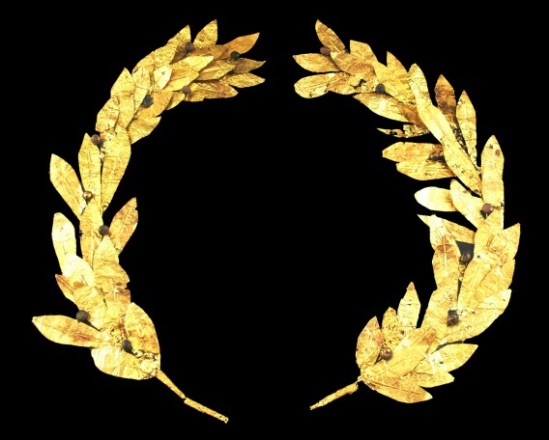
This August, athletes will gather around the world at Rio de Janeiro for the 2016 Olympic Games, well, the ones who aren’t dissuaded from coming by fears pertaining to lack first respondents at the premises, Zika virus, pollution, and all the other ugly stuff going on in Brazil at the moment. Way before we had the modern Olympic Games of today, there were those of Ancient Greece. The first recorded Olympic Games in history was held at Olympia in 776 BCE which only featured one event, a foot race across the stadium. The first Olympic Champion was a cook and baker named Koroibos of Elis and from then on, every victor was recorded and each Olympiad after them. This gave us the first accurate chronology of the Greek world. However, whether this was the first Olympic Games in history will never be known. As to how they got started is a mystery. And it doesn’t help that Greek mythology isn’t noted for its consistency. Some attribute the origins to Zeus celebrating his victory over his father Kronos. Others attribute them to Pelops in honor of his father-in-law Oinomaos. Another legend attributes their founding to the famous Greek mythological hero Heracles (or Hercules as you know him). At any rate, organized athletic competitions already existed in both the Minoan and Mycenaean civilizations even if their sporting events were originally associated with funeral rituals, particularly those who’ve fallen in battle like the games of Patrolcus in Homer’s Iliad (organized by Achilles, no doubt). Nevertheless, every 4 years, people from all over Greece and beyond would flock to the sacred city of Olympia whether they be athletes seeking a prize, spectators, trainers, officials, and what not. When a 19th century French aristocrat named Baron Pierre de Coubertin decided to found the International Olympic Committee and restore to the Olympic Games, he intended to restore the games to as close to the Greek spirit as possible but without the religious elements, banning women from watching, and nudity. Yet, de Coubertain’s view of the Ancient Greek Olympics was kind of romanticized and sometimes unfair as best seen when Jim Thorpe was stripped of his medals because he played semi-pro sports (while the athletes were supposed to be amateurs). Meanwhile, the Ancient Greeks? They didn’t even have a designation on amateur or pro in their vocabulary. Nevertheless, the Olympic Games were quite different in Ancient Greece from the ones we’re used to.

Here’s a close visual approximation on what Ancient Olympia might’ve looked like. But during antiquity, this would be where the Olympic Games were held every 4 years to honor the king of the gods Zeus.
Differences from the modern Olympic Games in general:
- It is only one of the Panhellenic Games in Ancient Greece with the quadrennial Pythian as well as the biennial Nemean and Isthmian. All these were sports festivals of Ancient Greek religious significance including the Olympics. However, the Olympics would remain the most prestigious of the four and best remembered.

Here’s an artist’s depiction on the Statue of Zeus in his Olympia temple. He was the chief deity of the Greek gods who threw lightning bolts whenever pissed as well as couldn’t keep it in his pants.
2. It was a sports festival to honor Zeus and always took place at the sanctuary of Zeus in Olympia from 700 BCE. And it was because of this that they were suppressed by Roman Emperor Theodosius in 394 as part of a campaign to impose Christianity as the state religion of the Roman Empire.
3. Greek city states marked this occasion with a 3 month Olympic Truce so athletes could travel to the Games in safety when there would be no war or battles and no capital punishment. Violation of that truce consisted of fines. Yet, city states would also use the Olympic Games as a political tool to assert dominance over their rivals as well as later spread Hellenic culture throughout the Mediterranean.
4. Also featured religious celebrations as well as art competitions.

Here is an olive wreath. Wreaths like these would be bestowed as prizes to Olympic victors along with an etching of their name to the winners roll (except for jockeys and charioteers). Further prizes bestowed on them would depending on their city-state of origin though they’d receive a hero’s welcome and other perks.
5. Prizes were only given to victors which consisted of olive leaf wreaths or crowns as well as other rewards from their home city states (Athenian Olympic winners could have a free meal in the City Hall every day for the rest of their lives as well as a substantial amount of cash). Chariot drivers only received red woolen ribbons worn on the upper arms or around the head while the horse owner received the crown. No Olympic medals in gold, silver, or bronze.

Here is a hanging of the kind of Olympic events you’d see in Ancient Greece. These included sports in the Pentathlon, Track, Combat, and Equestrian.
6. Had fewer events and lasted for 5 days during the summer at the first full moon after the summer solstice (like mid-July). There were no winter events. However, athletes had to arrive one month before the games and had to declare that they’ve been training for at least 10 months.

Despite that women weren’t allowed to even watch the Olympic Games in Ancient Greece under penalty of being thrown off Mt. Typaion (well, at least married women anyway), here you see women in Grecian dress at the most recent Olympic torch ceremony at the ruins of Olympia. I’ll get to the torch part later.
7. Only freeborn Greek men and boys who were citizens from Greek city states were allowed to participate (as long as they had a clean record, didn’t defile any temples, or violate the Olympic Truce). Married women weren’t even allowed to watch on penalty of death via being thrown off Mt. Typaion (though they could enter their horses in the equestrian events as well as chariot teams. But they couldn’t drive the chariot themselves. But men who were foreign born and slaves could and did. Also, unmarried girls could watch as well as the Demeter Chamyne priestess). However, ladies can compete, organize, and officiate in the Hera Games as long as they weren’t married but these consists of foot races, chariot racing, wrestling, and dances.

Unless they were in the hoplite races or the equestrian events, Ancient Greek Olympic athletes usually performed naked. It was part of the Olympic dress code. Yes, I know it’s kind of weird but it’s an Ancient Greek thing.
8. Athletes competed in the nude unless noted otherwise. Exceptions were hoplite racers (who competed in armor) as well as jockeys and charioteers (for obvious safety reasons). Trainers were required to be nude after an athlete’s mother tried to pass herself off as one (but wasn’t executed because she was from a prominent Olympic family).

Despite the association of lit torches with the Olympics, the Ancient Greeks had no Olympic torch relay. Other Ancient Greek sporting events did, however, including Athens.
9. There was no torch relay (though other Panhellenic Games did have torch relays in their other athletic festivals, including those at Athens).
10. Events were supervised by trained judges from Elis, the Hellanodikai (or agonothetai) who also had various assistants such as the alytai (police officers or referees). Originally these were inherited positions but they were later chosen by lot. They also had the power to disqualify, sort separate the men athletes from the boys (usually by physical appearance), and fine athletes for rule infringement. These guys wore purple cloaks and had special seats of honor in the stadium. Their decisions could never be revoked but they were subject to a council of elders and could be fined if any athlete successfully appealed.
11. Penalties for rule breaking ranged from exclusion and fines to flogging. Fines were paid to the sanctuary and the wronged athlete. But if an offender could not afford to pay the fine, then the city absorbed the penalty or else faced exclusion from the next Olympic Games.

Just a bunch of guys training in the Olympics. Note how most of them have toned bodies like you’d see from 300. Don’t think that’s realistic. Come on.
12. First day consisted of an opening ceremony, judges and athletes taking oaths, competitor registration and scheduling, as well as sacrifice presentations to the gods. Second day consisted of the equestrian events and pentathlon before ending with honor the shrine of Pelops and a parade at the sanctuary of Zeus that included feasting and revelry. Third day had arrival of judges, ambassadors, competitors and Great Altar sacrificial animals, afternoon running races, and a public banquet at the Prytaneion. Fourth day was devoted to combat sports which ended with the hoplite race. And the fifth day was devoted to the closing ceremony.

While there is an Ancient Greek legend of the first marathon of a messenger running a great distance to inform the leaders of their victory there before collapsing and dying, there was no Ancient Greek Olympic Marathon. Because Ancient Greek athletes weren’t that crazy to run 26 miles.
13. Despite the name having Greek origins as well as a famous story to go with it from the Persian Wars, there was no Olympic marathon.
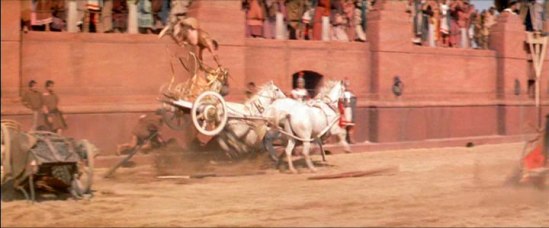
Sure this is from the chariot scene in the 1959 Ben Hur which takes place in Ancient Roman times and in 1st century Palestine. However, this is a very historically accurate portrayal on what ancient equestrian events were like. Ancient Greek Olympic chariot racing wouldn’t have been much different since it was a very violent sport with most races experiencing at least one crash and fatalities weren’t unheard of. Ancient chariot races would make today’s auto races seem like mere tea parties.
14. Equestrian events took place in the Hippodrome and were the province of the elite who can afford to equip and maintain horses and a chariot as well as cover the costs of trainers and the charioteer or jockey (who were usually paid servants, family members, or slaves). Only the owners received the olive wreaths and Altis statues, not the athletes. Yet, unlike the equestrian events of today, they appealed to the less than idealistic spectator instincts like “shock value TV” nowadays. Most of the fascination was predicated by their violent nature with the races being quite dangerous and sometimes fatal (think of the Ben Hur chariot race scene. Most chariot races had at least 1 crash per race). Collisions, crashes, and horse wrecks were common, especially near the critical turning post. Equestrian race lengths were grueling distances.

And here’s another picture from the chariot scene in Ben Hur. Notice how Judah knocked Messala off his chariot away from the spiked wheel which means he’s likely going to die sometime later. Ancient Greek Olympic chariot racing was quite similar in its violence. And the violence in these equestrian events contributed to the entertainment value. Remember these sports weren’t for wimps.
15. Athletes caught cheating had to build a statue of themselves and engrave their name on it so that the city people would know who might cheat in life. These statues were called Zanes.
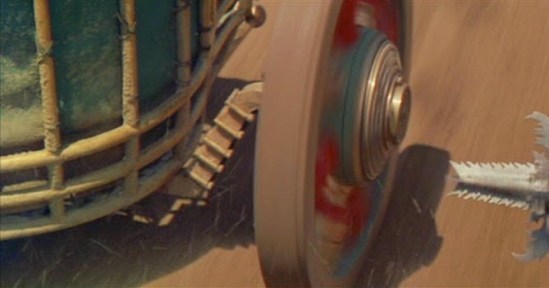
Like the Roman chariot race scene in Ben Hur, cheating was also frequent in the Ancient Greek Olympics. However, while those caught cheating had to engrave their names on a Zane statue, they were never made to forfeit their winnings. Just a bad reputation. Yeah, I know it’s pretty awful but a winner was a winner in Ancient Greece even if he was corrupt. Like Tom Brady and the New England Patriots which won 4 Super Bowls.
16. If a winner was caught cheating, he was never made to give up his winnings despite his corruption. Nevertheless, cheating was very common in these games with other participants tampering with other athletes’ equipment, bribing officials, or making them fall during a chariot race (again think of Ben Hur with Messala’s metal spike on his wheel that would basically grind into his rivals’ wheels and cause them to wreck. However, given that Messala is an aristocrat and an officer, it’s very unlikely that he’d be driving his own chariot. Chances are he’d hire someone to drive it for him).
17. No measurements were recorded of the length pertaining to a jump, discus, or javelin throw. No times were kept for the running events. But winners’ names might be recorded but they wouldn’t be considered record holders. Because breaking records wasn’t a thing.
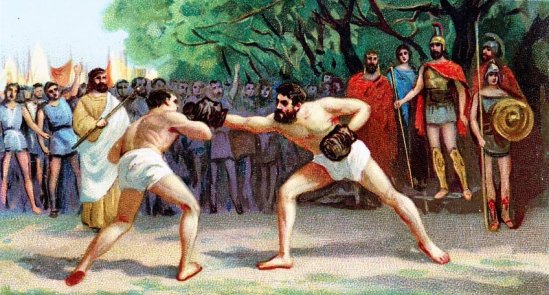
This is probably not an Ancient Greek Olympic event depiction due to a female presence. Yet, while modern combat sports match contenders through weight classes, this wasn’t the case in Ancient Greece. During their Olympics, people were matched up according to lot, though the unluckier athletes had a chance to forfeit.
18. Combatants were matched to each other by matching lots before each round. Unlucky athletes matched up against a much stronger opponent usually had the opportunity to withdraw before it was too late to avoid serious injury.
19. Runners and horse racers were sorted into their names by lot.

And here are the ruins of what’s left of the Temple of Zeus in Olympia. It’s said to be one of the 7 Wonders of the Ancient world according to Herodotus.
The events were also quite different in the Ancient Greek Olympic Games. Sure we have some of these events in our modern Olympics, but they’re not quite conducted like nowadays. Some of them are not on the modern Olympic sports roster due to obvious reasons like safety and cruelty to animals. Other events you see in the modern Olympic Games were either not known in Greece at the time or even invented.

This is what’s left of the Olympia stadium which hosted the Ancient Greek Olympics. At one time, it could hold about 45,000 spectators (and not a single woman among them, well, as far as the rules are concerned).
Greek Olympic Events:

Olympic victors in Ancient Greece would become instant celebrities and were celebrated like heroes in their home town. Here is a victor being bestowed an olive wreath from Nike, the Greek goddess of victory.
Track:

Track events were a long time staple of the Ancient Greek Olympics, which hosted 4 of these. These include 3 races of varying distances as well as a hoplite race where participants were clad in armor.
- Stadion – From Olympic Legacy: “The “stadion” was a simple sprint from one end of the stadium to the other, a distance of 600 feet (192.27 meters). This premiere competition of the ancient Olympics was the only event for the first thirteen Olympiads and was never omitted from the program in a millennium. In addition, the stadion became part of the pentathlon when it was introduced in 708 BC.”
- Diaulos- From Olympic Legacy: “At 1,200 feet (384.54 meters), the “diaulos” was double the length of the stadion. This second-oldest event was run in a straight line from one end of the stadium to the other and back, rather than in an elliptical lap, as we do today.”
- Dolichos- From Olympic Legacy: “Although the exact distance that “dolichos” runner had to traverse is not clear, it is known that this was a lengthy race, requiring great endurance. It is possible that the length was 24 stadia, or 14, 400 feet (4,615 meters).”

The Hoplitodromos was usually the grand finale of each Ancient Greek Olympic Games. This consisted of athletes running 1,200 ft across the stadium in full hoplite armor. And yes, it was probably not comfortable to do that in mid-July, especially in Greece.
4. Hoplitodromos- From Olympic Legacy: “This theatrical event was the grand finale of each Olympiad. Participants raced the length of a diaulos (1,200 feet / 384.54 meters) with helmet, greaves (lower-leg armor), and a round shield. This militaristic closing event was a reminder that the Olympic truce was almost over.” These were the only runners who didn’t compete in the buff but this was probably not pleasant for the athletes. Think of the armor coming off loose, men tripping and falling, as well as other crowd pleasing chaos.
Pentathlon:

In Ancient Greece, the Pentathlon was a major spectacle that consisted of 5 events like 200m dash, javelin, long jump, discus, and wrestling. Nowadays, discus, javelin, and long jump are considered separate events. Not so in Ancient Greece.
- Pentathlon- From Olympic Legacy: “The pentathlon consisted of five competitions. The 200-meter dash ( [stadion] ) and [wrestling] were events in their own right, but the remaining events (long jump, discus, and javelin) were only part of the pentathlon competition. Unfortunately, little is known about the order of competition, rules, or how a winner was determined. It is certain, however, that pentathletes (who were greatly admired in antiquity) must have possessed incredible endurance in order to compete in five events in one afternoon. Although it is not known who invented it or how it originated, we do know it was a very popular event.”

Unlike its modern counterpart, the Ancient Greek Olympic long jump was quite different. For instance, pentathlon athletes used small weights on each hand to pull this off. It wasn’t easy to accomplish.
6. Long Jump- From Olympic Legacy: “The most significant difference between the ancient long jump and its modern cousin is in the use of jumping weights called “halteres.” These small weights held in each hand were swung forward with great force as the jump was launched to propel the jumper forward as much as possible. They would then be swung back and down just before landing. This technically challenging feat was often performed to the accompaniment of flute music, which helped the athlete to maintain the necessary rhythm and spilt-second timing. The jumps took place in a rectangular sand pit in the stadium, with a small take-off ramp on one side. It is unknown whether the long-jump of antiquity was a single, double, or even triple jump.”
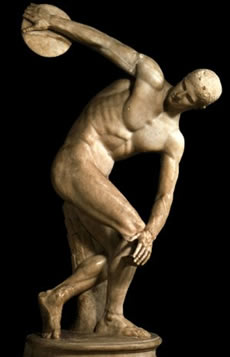
Here’s a an Ancient Greek sculpture of an Olympic discus thrower. Unlike today’s throwers, pentathlon athletes back in Olympia probably threw no further than with a 3/4 turn. The discus itself was either made of stone or metal.
7. Discus- From Olympic Legacy: “This curious sport lives on in the modern Games. The graceful poses of ancient throwers were almost the same as those of today, except that it is likely the ancient athlete made no more than a three-quarter turn, in contrast to the full spins that are standard technique today. Very little is known about the length of throws in those days, although any figure would have little meaning without knowing the weight of the discus that was thrown. Discuses, which were made of stone or metal, were often marked with inscriptions. The terms of the ancient Olympic truce were engraved on a discus and displayed in the Altis.”

Ancient Greek pentathlon athletes used a leather throng to fling the javelin. It helped if the athlete had military training because soldiers relied heavily on javelins as an offensive weapon.
8. Javelin- From Olympic Legacy: “This event is another example of the traditions that live on the Games of today. In ancient times, this was not a idle sport—warriors relied heavily on the javelin as an offensive weapon. The only real difference between the ancient and modern versions of this event is the use of the “anklye”—a leather thong used to fling the javelin. This strap, which was wound around the shaft and held by its free end, unwound as the spear was thrown, making the javelin spin and ensuring a steady flight.”
Combat:

Here’s a painting depicting an Olympic wrestling match from Ancient Greece. I know it involves a couple of naked guys going at it which I’m aware will upset parents and Bible Belt Christians. But this is what Ancient Greek combat sports were like. I’m trying to enlighten people here.
- Wrestling- From Olympic Legacy: “Matches were held in an area filled with sand. Once a match began, it continued without interval until one man had thrown his opponent three times (touching the ground with the back, shoulders, or hip constituted a fall). There were no divisions by weigh, and the bigger men tended to win. Contestants were allowed to trip, but not to bite, gouge, or punch. Over the years, the variety of holds and tricks grew in number and sophistication. Wrestling became the final event of the pentathlon when it was introduced in 708 BC.”

Here’s an Ancient Greek sculpture of an Olympic boxer. Boxing was one of the most brutal sports at the time. And participants often ended up disfigured (since most boxers bashed each other’s heads). Too bad the leather straps didn’t offer much protection.
10. Boxing- From Olympic Legacy: “Although ancient boxing is similar to its modern counterpart, matches were not conducted in a roped-off ring and there were no breaks and no time limit. Victory was declared when one opponent was knocked out or conceded the contest. No wrestling or holding were allowed, but it was possible to hit a fallen opponent. Virtually all blows were directed to the head, while the body was left exposed. A series of hand straps evolved over the years, culminating in a relatively sophisticated glove. This hand-gear did not lessen the violence of this sport, and ancient boxers were very recognizable by their “cauliflower ears” and other facial disfigurements.” Serious injuries were common and fatalities weren’t unknown. It was considered to be the most violent sport in Ancient Greece.

Panrkation was an a very brutal, empty hand submission, and all-in type of wrestling in Ancient Greece with scarcely any rules other than no gouging eyes or biting. Basically combatants do almost whatever it takes to pummel their opponent to the ground. Used techniques or wrestling, boxing, and others. It’s the Ancient Greek equivalent to MMA.
11. Pankration- From Olympic Legacy: “This hugely popular event, which ancient poets were inspired to immortalize with numerous odes, is unlike any competition today. It was a conglomeration of elements from boxing, a form a wrestling known as “ground wrestling,” and elements quite unique to itself. Judging by what was allowed—competitors could strike with the fist, an open hand, twist arms, even break fingers!—the pankration seems very violent, yet it was considered less dangerous than boxing. Much of the struggle took place on the ground, although several upright holds were popular. In contrast to the sand-filled wrestling square, the pankration was conducted in an area where the ground was watered and somewhat muddy.” In a nutshell, this is the Ancient Greek equivalent to MMA and UFC in which the only illegal moves were eye gouging and biting. Also experienced some occasional fatalities.The famous Greek philosopher Plato was said to do extremely well in this event. Yes, that Plato. Yeah, you probably don’t imagine your Greek philosophers doing MMA stuff. But if he wasn’t, he’d be just known as Aristocles.
Equestrian:

This is a 1908 painting of the Ben Hur chariot scene where Judah gets back on his chariot and eventually knocks Messala down which sends him to his eventual death. In Ancient Greek Olympics, this type of chariot racing was called Tethrippon which consisted of 4 horse chariots doing 12 laps across the track. It’s more like Ancient Greek NASCAR than contemporary harness racing while much more violent and much less safe. Seriously, people actually died in these races.
- Tethrippon- From Ancient History Encyclopedia: “the four-horse chariot race added in 680 BCE, run over ten or twelve circuits of the hippodrome. A version using foals over 8 circuits was added in 384 BCE.” Keep in mind that 12 circuits translates to 14 kilometers or 8.7 miles.

Ancient Greek Olympic horse racing was extremely dangerous since jockeys rode with no saddles, stirrups, horseshoes, or safety equipment. They were also riding on rough ground. So if riders were thrown off their horses, they would die.
13. Keles- From Ancient History Encyclopedia: “a horse race added in 648 BCE and run over 6 circuits. A version for foals was added in 256 BCE.” Keep in mind that 6 circuits equal 7 kilometers or 4.3 miles. Remember that horseshoes, saddles, and stirrups weren’t invented yet though whips were sometimes employed. It was especially dangerous because the ground was so rough. Riders thrown to the ground usually died. This kind of horseback riding isn’t one for wimps and perhaps the most dangerous.
14. Apene- From Ancient History Encyclopedia: “a race with chariots pulled by two mules, added in 500 BCE (dropped from 444 BCE).”
15. Kalpe- From Ancient History Encyclopedia: “a trotting horse race for mares, added in 496 BCE (dropped from 444 BCE).” FAMSF adds: “After a few laps around the track on the animals’ backs, the riders jumped off and ran the last lap alongside the galloping horse. In addition to the challenge of trying to keep up on foot with a horse, the competitors also had to avoid being trampled to death.” Wonder what the body count on this sport was. This just seems so stupid.
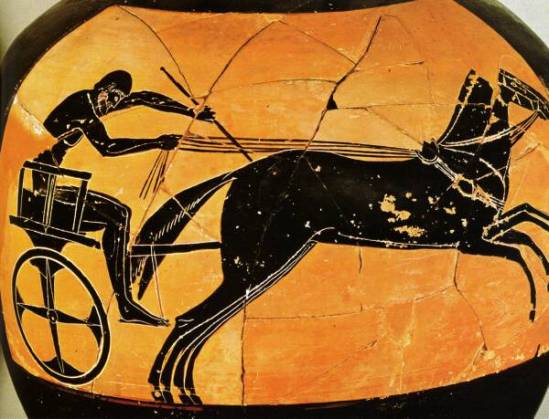
While the Tethrippon consisted of a chariot race pulled by 4 horses, the Synoris chariots were pulled by 2. But it’s way more dangerous than modern harness racing.
16. Synoris- From Ancient History Encyclopedia: “the two-horse chariot race run over eight circuits of the hippodrome, added in 408 BCE. A version using foals over three circuits was added in 268 BCE.”
Other:

Alongside athletic events, the Ancient Greek Olympics had a contest for trumpeters. The winner would be seen as the herald of the Games.
- Herald and Trumpeter Competitions- From Ancient History Encyclopedia: “added in 396 BCE. This was held on the first day and the winners – those whose sound carried the furthest – were also given the honour of announcing the victors on the final day at the official prize-giving event.” At least people didn’t die in this event.



Pingback: Purathrive Infonavit Nascar Sprint | Purathrive